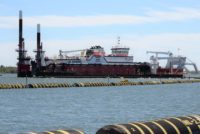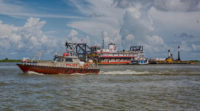Before the end of the year, the first in-stream hydrokinetic turbine to produce commercial power will be installed in the upper Mississippi River — just days after receiving the a first of its kind approval from the Federal Energy Regulatory Commission for the device.
Hydro Green Energy LLC of Houston will place its 12-feet in diameter turbine about 50 feet downriver from the Army Corp of Engineers Mississippi Lock and Dam No. 2 in Hastings, Minn. A second turbine will be installed in the spring. At an expected river flow of 2 meters per second, the turbines are expected to have an output of 35kW and an average annual generation of about 364 MWh.

The order marks the first time that FERC has approved the installation of a hydrokinetic device at an existing hydropower project. Hydrokinetic is low-impact hydro power, or turbines that use river currents/flow to generate electricity—without damming or otherwise affecting the normal river flow.
The FERC ruling "is an exciting one for everyone because it combines the use of innovative hydrokinetic technology with a conventional hydropower dam," FERC Chairman Joseph Kelliher said in a statement.
Because the project was at an existing hydro site, Hydro Green simply had to apply with FERC to amend that license, a process that took eight months. That’s a fraction of the two to five years currently required to license any hydro project with FERC.
“I would argue that we had to do a mini-license,” said Mark Stover, vice president for governmental and external Affairs for Hydro Green. “There was still a lot of paperwork involved.”
FERC issued the license on Dec. 13, but this week Hydro Green was still completing some additional paperwork and waiting for a break in the weather to install the turbine on a barge that will be anchored. Preliminary staging was completed earlier this month including attaching the turbine to the barge. Portable Barge Services of Newport, Minn., is performing the river installation. Stover says he expects the turbine will produce commercial power for the city of Hastings in January. He said the company does not have a cost yet for the project, but that its cost are equivalent to biomass or geothermal, and cheaper than solar.
The burgeoning hydrokinetic industry will be watching the project closely to determine whether modeling showing the potential of river currents is accurate. In 2008, FERC approved 123 preliminary permits for in-stream hydrokinetic devices — a four-fold increase over 2007. The permits give companies two years to study a site before applying for a FERC license. While many companies, including Hydro Green and Gloucester, Mass.-based Free Flow Power, have done extensive modeling on the in-stream devices, no real world testing has yet been done.
“The only way you’re going to know if they work is to put in them in the water, said John Seebach, director of the hydropower reform campaign for American Rivers. Seebach said that much of the damage associated with hydropower is tied to dams. “We’re cautiously optimistic about it,” Seebach says of hydrokinetic technology.
The Electric Power Research Institute has estimated that 3,000 MW of new power will be generated by in-river hydrokinetic technology by 2025. The National Hydropower Association says that number is too conservative.
Extensive testing on fish and bird mortality and water quality will be conducted on the project. A fish study, that Stover says will cost more than the equipment used in this project, will begin after the second turbine is installed this spring.
“We’re very much focused on the environment,” he says.
Stover says testing has shown that the project will allow more than 99% of the fish to survive they go through the turbine. The turbine’s fixed blades will move at 21 rpm � slower than other hydrokinetic designs, Stover says.
The turbines will be suspended from barges floating in the river, a design that Hydro Green says is important because of the unknowns surrounding hydrokinetic technology. If there were environmental or other problems, the blades could be stopped on site, or remotely by computer.
“We could remove device in one day and it would be gone,” says Stover.
Concepts NREC of White River Jct., VT, is developing the engineering and design of the turbines that were initially designed by Hydro Green founder and CEO, Wayne F. Krouse.
Stover says the design will change and become much more efficient over the next year as Hydro Green determines what works best.
The design of the second, he says, is even different than the first because Hydro Green learned how to more efficiently manufacture the turbine at TC American in Waite Park, Minn. The company also chose to focus on durability rather than efficiency or output for the first units.
“We left some power and efficiency on the table because we wanted to make sure we built the most rugged device,” he says. Six months after New York’s Verdant Power installed turbines in the East River to take advantage of tidal power, the turbines had to be pulled out and reworked because the tidal forces were damaging the turbines.
The Hydro Green turbines have a nameplate capacity of 100 kW and could provide at least double the output at some on the lower Mississippi River or in the Niagara River � sites that Hydro Green may put test turbines in later this year, Stover says.
Hydro Green has 16 preliminary permits with FERC.



Post a comment to this article
Report Abusive Comment